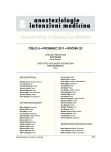The fascial plane concept
Authors:
Nalos Daniel 1; Mach Dušan 2
Authors‘ workplace:
ARO Masarykova nemocnice v Ústí nad Labem, Krajská zdravotní, a. s.
1; ARO Nemocnice Nové Město na Moravě
2
Published in:
Anest. intenziv. Med., 22, 2011, č. 6, s. 317-319
Category:
Anaesthesiology - New concepts
Overview
The muscular fascias surrounding peripheral nerves create an enclosed space. Their elasticity determines the size and shape of the space thus affecting the distribution of local anaesthetics. We suggest that application of a local anaesthetic into an “optimal” space outlined by the fascial planes, in particular under ultrasound guidance, largely determines the quality of the peripheral nerve block. In contrast, effort to apply local anaesthetics as close as possible to the peripheral nerve increases the risk of peripheral nerve damage. On the basis of histological studies of the tissues surrounding the nerves, CT and MRI studies performed on the author and other healthy volunteers, and clinical studies using ultrasound imaging we propose that the “fascial plane concept” enhances the safety of peripheral nerve blocks. We speculate that using the “fascial plane concept”, nerve injury and neurological damage as a consequence of peripheral nerve blockade will have lower incidence thus enhancing the safety of regional anaesthesia.
Keywords:
regional anaesthesia – muscular fascias – ultrasound – peripheral nerve block
Sources
1. Horáček, M. Farmakodynamika – mechanismus účinku lokálních anestetik. In Nalos, D., Mach, D. Periferní nervové blokády. Grada : Praha, 2010, p. 37–41.
2. Rogozov, V. Rozvoj periferních technik regionální anestézie. In Nalos, D., Mach D. Periferní nervové blokády. Grada: Praha, 2010, p. 28–30.
3. Nielsen, K. C. et al. Influence of obesity on surgical regional anesthesia in the ambulatory setting: an analysis of 9,3038 blocks.
4. Bigeleisen, P. E. et al. Extraneural versus intraneural stimulation thresholds during ultrasound-guided supraclavicular block. Anestesiology, 2009, 110, p. 1235–1243.
5. Tsai, T. P. et al. Intensity of the stimulating current may not be a reliable indicator of intraneural needle placement. Reg. Aneast. Pain Med., 2008, 33, p. 185–188.
6. Choyce, A. et al. What is relationship between paresthesia and nerve stimulation for axillary brachial plexus block? Reg. Anaesth. Pain Med., 2001, 26, p. 100–104.
7. Perlas, A. et al. The sensitivity of motor response to nerve stimulation and paresthesia for nerve localization as evaluated by ultrasound. Reg. Anesth. Pain Med., 2006, 31, p. 445–450.
8. Staender, S. et al. A Weiss Anaesthesiology Closed Claims Analysis: report of events in the years 1987–2008. Eur. J. Aneasthesiol., 2011, 28, p. 85–91.
9. Hove, L. D. et al. Closed claims from Switzerland: an important contribution to improving patient safety in anaesthesia. Eur. J. Aneasthesiol., 2011, 28, p. 77.
10. Nalos, D. et al. Ultrazvukem naváděný mediální cervikální blok. Anest. intenziv. Med., 2011, 22, 5.
11. Casutt, M. et al. Intermediate cervical Plexus Block for Carotid Endarterectomy: Case Series of the Spread of Injectate. J. Anesth. Clinic Res., 2011, 2, 2.
12. Nalos, D. et al. Superficial and interfascial cervical block – MRI study. Anest. intenziv. Med., 2011, 22, 4.
13. Nalos, D. et al. Fascie brachiálního plexu. Anest. intenziv. Med., 2010, 21, 4, s. 185–190.
Labels
Anaesthesiology, Resuscitation and Inten Intensive Care MedicineArticle was published in
Anaesthesiology and Intensive Care Medicine

2011 Issue 6
Most read in this issue
- Principles of mechanical ventilation in chronic obstructive pulmonary disease
- Severe course of Still’s disease with multiple organ failure with predominant liver failure
- The fascial plane concept
- To cool or not to cool? Obstacles to implementing therapeutic hypothermia guidelines
